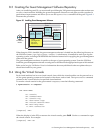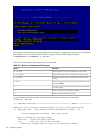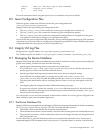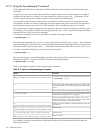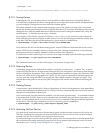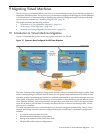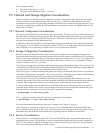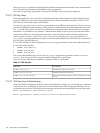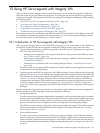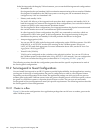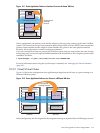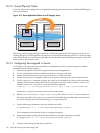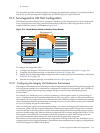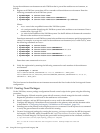This example specifies:
• The name of the guest (-P VM1)
• The name of the destination host (-h HostB)
9.3 Network and Storage Migration Considerations
Effective migration of VM Host systems depends on proper configuration of the networks and storage
used by the source and destination hosts. The hpvmmigrate command verifies that the source and
destination hosts provide the guest with symmetric accessibility to network and storage resources. If you
set up the configuration properly on both hosts before you migrate the guest, the migration task will be
much easier and faster.
9.3.1 Network Configuration Considerations
The source and destination hosts should be on the same subnet. The hpvmmigrate command preserves
the MACaddress of the guestbeing migrated. Thus,having the hosts onthe same subnetprevents problems
that can occur from changing the guest’s host name or IP address. With both hosts on the same subnet,
the guest boots properly on the destination host.
In addition, ensure that all pNICs are symmetrically configured on both the source and destination hosts.
For example, if lan0 on HostA is connected to subnet A, and lan1 is connected to subnet B, make sure
that, on HostB, lan0 is connected to subnet A and lan1 is connected to subnet B.
9.3.2 Storage Configuration Considerations
Both the source and destination hosts must share access to symmetrically configured storage devices.
Specifically, bothhosts must use the samecharacter disk-device file name foreach disk device. For example,
both the source and destination hosts would refer to the same disk device as /c0t1d0. (To configure the
source and destination systems with the same device file names, use the ioinit command to reassign
instance numbers to the ext_bus class.)
Also, thesame storagedevices mustbe visibleto boththe sourceand destination hosts.The hpvmmigrate
command usesthe Fibre Channel worldwide identifier (WWID)to determine whetherthe storage allocated
to a guest on the source host is also reachable on the destination host.
The hpvmmigrate command assumes that guests use storage area network (SAN) resources specified as
whole-disk backingstores (for example, /dev/rdsk/c26d5t2). Althoughyou cancreate virtual machines
with direct attached storage (DAS), guests that use DAS cannot be migrated.
SAN logical units (LUNs) are presented to both the source and destination hosts. However, it is not
necessary to presentLUNs to the guests; theyare made available by the VMHost when the virtual machine
is booted. This configuration allows you to migrate guests without having to reconfigure the SAN.
To avoid inadvertently using the disk devices associated with a guest on more than one host, mark as
restricted all the disk devices used for guest storage on all hosts, except the disk that contains the guest.
To mark a disk as restricted, use the hpvmdevmgmt command. For example:
# hpvmdevmgmt –a rdev:entry_name
The –a option accepts the name of the device to be restricted. For example:
# hpvmdevmgmt –a rdev:/dev/rdsk/c4t1d0
For more information about the hpvmdevmgmt command, see Chapter 6 (page 61).
After the guest is successfully migrated, the hpvmmigrate command marks as restricted all the disk
devices allocated to the guest on the source system to prevent any other guests from using them. On the
destination host, the disk devices allocated to the migrated guest are marked as unrestricted.
9.3.3 Security Considerations
The hpvmmigrate command requires HP-UX Secure Shell (SSH) to be set up on both the source and
destination host systems. SSH provides a secure communication path between hosts and is installed on
HP-UX 11.23 systems by default. To enable secure communication between the source and destination
hosts, you must generate SSH keys on both systems.
9.3 Network and Storage Migration Considerations 113



